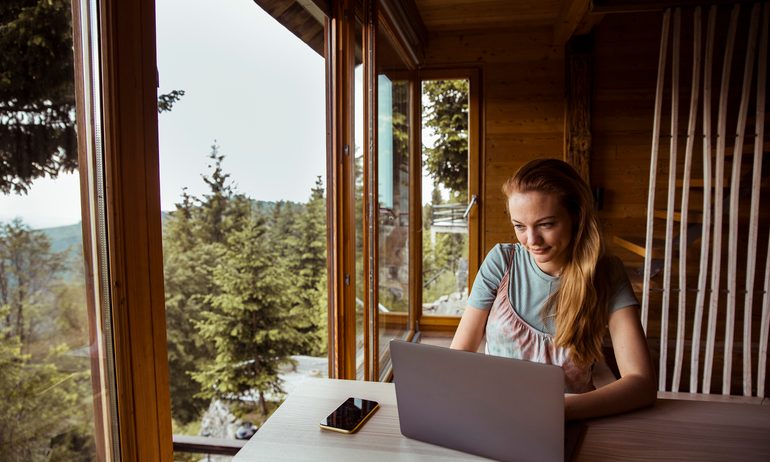What Pandemic Travel Changes Are Likely Here to Stay?
The pandemic has changed the standards for working on the road and cleanliness on airplanes.

Many or all of the products on this page are from partners who compensate us when you click to or take an action on their website, but this does not influence our evaluations or ratings. Our opinions are our own.
The COVID-19 pandemic changed the way the world works, eats, communicates and, yes, how it travels. Over the course of the last year, we’ve seen a myriad of changes in the travel industry, from in-flight meal service adjustments to the outright banning of travel to certain regions, and everything in between.
Even as the vaccine rollout continues in the U.S. and around the world, the travel experience you knew in 2019 won't be the travel experience you encounter in 2022.
But the question now is: Which of these changes are simply pandemic-era sidesteps and which will stay around for good? As our travel writers survey the landscape of the travel world, here’s what they think will stick and not go back to pre-pandemic “normal.”
Workcations
Workcations caught on during the pandemic due to the boom in remote work, and they likely won’t go away. The premise is simple: Book accomodations for longer than usual, but still work eight hours in your (virtual) office. Instead of a long-weekend tropical beach trip, you spend two weeks there.
You get to wake up to a sunny coastline. Rather than taking your dog on a mundane morning walk around the neighborhood, you’re now strolling in a warm sun and ocean breeze. Plus, you have two full weekends of enjoying the beach and general out-of-the-house relaxing — not to mention free evenings once you close your laptop for the day.
And you won’t even have to burn any vacation days. The rental house has Wi-Fi, so you’ll be able to videoconference and submit your digital assignments as usual.
It sounds all good, right? In many ways, it is: new scenery, the opportunity to try dozens of new restaurants, going through a larger percentage of your trip without jet lag. But it’s not necessarily all good. If you can work one day of your vacation, why not every day?
Too many vacation days already go unused. According to 2019 research from the U.S. Travel Association, Oxford Economics and Ipsos, though employees earned an average of 23.9 days of paid time off in 2018, more than a quarter (27.2%) of them went unused — up from 25.9% in 2017.
A year of remote work showed us how feasible a workcation can be, but as that trend likely sticks, potentially even more vacation days will go unused.
While more days away from home could certainly be good, workcations can rob you of the benefits of fully unplugging, engaging and relaxing. It might be harder to enjoy the local delicacy on your breakfast plate if you’re also thinking about the tasks on your work plate.
Sally French
Business travel decline
Business travel has always been a kind of weird idea. Do those well-dressed executives in first class really need to shuttle themselves around the world when a conference call could solve the same problem? The pandemic helped answer this question: Nope.
Granted, some professions require in-person interaction, but the vast majority does not. And as organizations reassess their budgets in 2022 and beyond, they might very well ask themselves, “Why were we spending so much on travel?” Business travel will certainly bounce back somewhat from its midpandemic nadir, but it will never be the same.
What will this mean for nonbusiness travelers? A lot, actually. Fewer business travelers mean less demand for popular air routes and downtown hotels. The first can be addressed by airlines reducing capacity on those routes, but the latter? Hotels built to house a steady stream of business travelers may remain below capacity for years.
Fewer business travelers also mean less competition for elite status and premium cabin upgrades. This shift could make it easier to snag these seats for leisure travelers with status or who book with points or miles.
Of course, institutional inertia is strong, and business travel could come roaring back once vaccines are widely distributed. But I wouldn't bet on it.
Sam Kemmis
Airplane cleanliness standards
Before the pandemic, disparaging comments about airplane hygiene were commonplace. “Don’t drink the tea or coffee on airplanes.” “Tray tables are the dirtiest part of the plane." And more.
However, as a result of COVID-19, airlines have implemented stringent cleanliness standards on aircrafts to assuage passenger worries about flying during the pandemic.
Although masks are now voluntary, the stringent hygiene standards that airlines have adopted might be here to stay. That said, several airlines have begun quietly loosening their polices. We've yet to see if others will follow suit.
Elina Geller
» Learn more: The best airlines to fly during COVID-19
The bottom line
A lot has changed, and we’ll likely see more changes to the travel industry as 2022 progresses. Vaccine passports, the need for booster shots or other alterations remain a distinct possibility. If you want to be a savvy traveler during the COVID-19 era, be flexible, patient and — most importantly — safe.
The Platinum Card® from American Express
Travel
Earn 5X points on certain flights (up to $500,000 per calendar year) and hotel stays, hundreds of dollars a year in credit for travel and shopping, and a suite of perks for high-end lifestyles.




